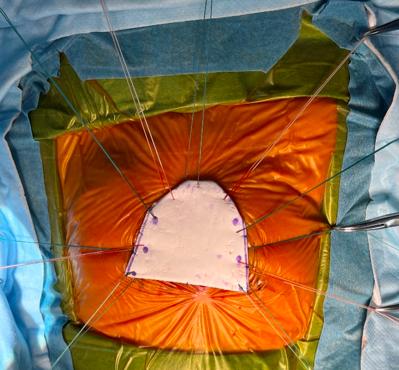
One day in November 2021, the baby Xiaoshuang fell to the ground at the Shanghai First Maternal and Child Health Hospital, but the scene in front of him surprised the obstetrician: a "bulge" the size of a ping-pong ball appeared in the chest area of the newborn, and the naked eye could see the heart beating violently inside...
The doctor then contacted the National Children's Medical Center (Shanghai) and the Heart Center of Shanghai Children's Medical Center affiliated to Shanghai Jiao Tong University School of Medicine through the cooperative network, and the children's center quickly sent a cardiac intensive care team to connect Xiao Shuang to the intensive care ward of cardiothoracic surgery.
It turned out that 5 months ago, Xiao Shuang's mother learned that the fetus had the possibility of sternal dysplasia during the 24-week pregnancy test, and was diagnosed with fetal Cantrell pentagram and sternal defect through the fetal nuclear magnetic resonance imaging (MRI) of Shanghai Children's Medical Center.
This is undoubtedly a major blow to the child's family, whether to keep this little life makes the whole family confused.
Through the joint diagnosis of the team of Professor Sun Yanjun of the Department of Cardiothoracic Surgery of Shanghai Children's Medical Center and the team of Professor Sun Luming of the Department of Fetal Medicine of the First Maternal and Child Health Hospital, considering that the fetal chromosomes and heart structure are normal, the experts gave suggestions for continuing pregnancy, and formulated a medical plan for the two major hospitals to work together to escort the child.
Thus, there is the opening scene.
In the intensive care unit, Xiao Shuang's heart was beating through the thin skin, lacking the protection of the sternum, and it seemed that any external stimulus would cause an unimaginable blow to it. Thankfully, after undergoing CT examination, the doctor diagnosed that Xiao Shuang did not have diaphragm and cardiovascular malformations.
The surgery was put on the agenda, carefully selected, and in the end, the experts decided to use bulked PTFE material to reconstruct the child's sternum.
November 26 is the day that Xiao Shuang received surgery, with the cooperation of the hospital's multidisciplinary cooperation, the operation proceeded smoothly: after the chief surgeon opened the baby's thin skin, he saw that there was a defect of about 3 * 4 cm in the middle and lower part of the sternum, the heart did not have any obstruction, and after using double mesh to cut into a suitable shape, intermittently suture was fixed to the edge of the sternal defect... Everything went according to plan.
After the operation, with the joint efforts of the cardiothoracic surgical intensive care unit and the neonatal intensive care unit, Xiao Shuang recovered and was discharged from the hospital.
According to chief physician Sun Yanjun, Cantrell pentathenia is a rare congenital malformation disease, with an incidence of less than five in a million, which was first described and named by Cantrell in 1958, including sternum defects, partial pericardial defects, anterior diaphragm defects, and the absence of the midline of the upper abdominal wall of the umbilicus such as with cardiac bulging and cardiovascular malformations, which can occur simultaneously, or can be dominated by sternal defect symptoms and not accompanied by other malformations.
The etiology and pathogenesis are unclear, and the pathogenesis may be related to the development of the lateral segment of the mesoderm during the embryonic development period of 14-18 days, resulting in hypoplasia of the diaphragm and obstruction of the migration of the head folds that form the abdominal wall. Survival depends mainly on the severity of the heart malformation, which is generally around 50%.
Diagnosis of fetal Cantrell pentathesis is not difficult, and ultrasound is the most convenient and accurate diagnostic method. Due to the breastbone defect, most of the heart is exposed and the circulatory system is unstable, and surgery is recommended as soon as possible. Children with Cantrell pentagram who do not have severe cardiovascular malformations have a high success rate and a good prognosis.
Many congenital malformations, especially heart and lung malformations, pose a serious threat to the life of newborns after birth, and the timing of treatment is particularly important. In the past, the process of examination, diagnosis and treatment after the newborn developed symptoms often failed to achieve the best treatment effect. At present, Shanghai Children's Medical Center has established a mature cooperative relationship with many maternal and child health hospitals in Shanghai, conducting perinatal consultation on various fetal congenital malformations, assessing and transporting them at the first time after birth, so as to achieve early diagnosis, early intervention, early treatment, and escort for newborns.
Author: Tang Wenjia Jiang Rong
Editor: Tang Wenjia
Editor-in-Charge: Fan Liping
Source: Hospital
*Wenhui exclusive manuscript, please indicate the source when reprinting.